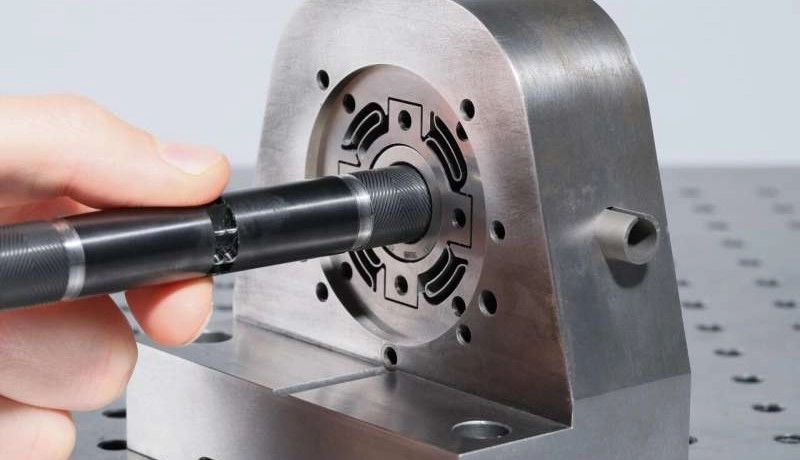Bearings, I believe everyone is familiar with them. The rolling bearings that we commonly use should be the most familiar. They are important components in contemporary mechanical equipment. So what is an air bearing?
In the early form of linear motion bearings, a row of wooden rods was placed under a row of skids. Modern linear motion bearings use the same working principle, but sometimes use balls instead of rollers. The simplest rotary bearing is the bush bearing, which is just a bushing sandwiched between the wheel and the axle. This design was subsequently replaced by rolling bearings, which replaced the original bushing with many cylindrical rollers, each like a separate wheel. In 1854, the French G.A Ian proposed the idea of using gas as a lubricant, and finally in 1896, the first air bearing came out.
Air bearing, as the name implies, the most commonly used gas lubricant for bearings using gas as lubricant is air, and nitrogen, argon, hydrogen, helium or carbon dioxide can also be used as needed. In gas compressors, expanders and circulators, the working medium is often used as a lubricant. In the selection of air bearing materials, there are mainly tool steel, bronze, tungsten-cobalt-molybdenum alloy, powder metallurgy porous materials, ceramics and engineering plastics.
Air bearing refers to a bearing that supports the load by means of the pressure air film formed between the sliding surfaces of the bearing, and the sliding surfaces are completely separated by the air film during operation. The air bearing belongs to the fluid sliding bearing in the sliding bearing. It is fluid lubricated during operation, and its lubricating medium is air.
According to the formation mechanism of the pressure air film, air bearings are mainly divided into two categories: aerodynamic bearings and aerostatic bearings.
The pressure air film of the aerodynamic bearing is formed by the mutual movement of the sliding pair to bring the air into the area of convergence between the surfaces of the sliding pair. The air film is roughly wedge-shaped, see Figure 1. Since aerodynamic bearings do not require an external air source, they are also called “self-acting bearings”.
The pressure air film of the aerostatic bearing is formed by the introduction of the external compressed air between the sliding surfaces through the restrictor, as shown in Figure 2. Aerostatic bearings require a clean external air source.
Air Bearing Features
① Very low friction
Since the viscosity of gas is much lower than that of liquid, the viscosity of air at room temperature is only one-fifth thousandth of that of No. 10 mechanical oil, and the frictional resistance of the bearing is proportional to the viscosity, so the frictional resistance of the gas bearing is lower than that of the liquid lubricated bearing.
② Wide range of applicable speeds
The gas bearing has low friction resistance and low temperature rise. When the speed is as high as 50,000 rpm, the temperature rise does not exceed 20-30 °C, and the speed is even as high as 1.3 million rpm. Aerostatic bearings can also be used at very low speeds, even zero speeds.
③ Wide temperature range
The gas can maintain a gaseous state in a wide temperature range, and its viscosity is little affected by temperature (the viscosity increases slightly when the temperature increases, such as the temperature increases from 20 ° C to 100 ° C, the air viscosity increases by 23%), therefore, the gas The applicable temperature range of the bearing can reach -265℃ to 1650℃.
④ Low carrying capacity
The load-carrying capacity of a hydrodynamic bearing is proportional to its viscosity, and the load-carrying capacity of a gas hydrodynamic bearing is only a few thousandths of that of a hydrodynamic bearing of the same size. Due to the compressibility of the gas, the bearing capacity of the gas dynamic pressure bearing has a limit value, and the load per unit projected area can only be added to 0.36 MPa.
⑤ High machining accuracy requirements
In order to improve the bearing capacity and air film stiffness of gas bearings, smaller bearing clearances (less than 0.015 mm) are usually used than liquid lubricated bearings, and the accuracy of parts needs to be improved accordingly.
Application of Air Bearings
Air bearing is a new type of bearing that uses air elastic potential energy to support. The only lubricant used is air; therefore, air bearing technology is ideal for workpieces or work environments that must be free of contamination.
In an air bearing, the balls are replaced by air cushions. Perhaps one of the most well-known applications of air bearings is in hovercraft.
Huge fans blow air beneath the hovercraft, preventing air from escaping through elastic rubber “skirts”. The high air pressure created below the hovercraft supports the weight of the hull, thus causing it to float on the air cushion.
Since the 1950s, the application of gas bearings has become more and more extensive, and has been extensively and deeply studied. At present, gas bearings can be used in textile machinery, cable machinery, instrumentation machine tools, gyroscopes, high-speed centrifuges, dental drills, refrigerators operating at low temperatures, hydrogen expanders, and gas circulators operating at high temperatures.










